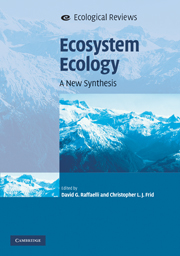Book contents
- Frontmatter
- Contents
- List of contributors
- Preface
- 1 The evolution of ecosystem ecology
- 2 Linking population, community and ecosystem ecology within mainstream ecology
- 3 Thermodynamic approaches to ecosystem behaviour: fundamental principles with case studies from forest succession and management
- 4 Ecosystem health
- 5 Interdisciplinarity in ecosystems research: developing social robustness in environmental science
- 6 The links between biodiversity, ecosystem services and human well-being
- 7 Ecosystem ecology and environmental management
- Index
- References
3 - Thermodynamic approaches to ecosystem behaviour: fundamental principles with case studies from forest succession and management
Published online by Cambridge University Press: 05 June 2012
- Frontmatter
- Contents
- List of contributors
- Preface
- 1 The evolution of ecosystem ecology
- 2 Linking population, community and ecosystem ecology within mainstream ecology
- 3 Thermodynamic approaches to ecosystem behaviour: fundamental principles with case studies from forest succession and management
- 4 Ecosystem health
- 5 Interdisciplinarity in ecosystems research: developing social robustness in environmental science
- 6 The links between biodiversity, ecosystem services and human well-being
- 7 Ecosystem ecology and environmental management
- Index
- References
Summary
Introduction
Ecosystems and organisms must obey physical laws. This statement, perhaps due to its obviousness, is extremely powerful. It forms the basis of how we model systems, living or otherwise, to understand their dynamics and behaviour. Mass and energy must be conserved, but many physical configurations can satisfy the conservation of mass or energy. Ecosystems follow the laws of thermodynamics, and the ways in which ecosystems obey these laws determine their behaviour.
This chapter discusses how classic and contemporary ideas from physics (via thermodynamics) and statistics (via information theory) have influenced the study of ecology. After reviewing the history of the thermodynamic approach in biology, basic physical and statistical concepts are reviewed, and their practical application demonstrated, and debated, using case studies of temperate forest succession in the south-eastern United States and global forest management for atmospheric CO2 mitigation after the Kyoto and Bali accords. Throughout, the different viewpoints of community ecology and ecosystem ecology are contrasted to place thermodynamic principles in a broader ecological context, and to explore ways to improve existing ecological theories.
Historical development and motivation
The thermodynamic approach to understanding biological systems was articulated most elegantly in a series of lectures by Erwin Schrödinger, recapitulated in a book entitled What is Life (1944). Schrödinger describes living systems as those that dissipate energy, or pass entropy to their surroundings, to maintain an ordered state that is far from thermodynamic equilibrium.
- Type
- Chapter
- Information
- Ecosystem EcologyA New Synthesis, pp. 40 - 64Publisher: Cambridge University PressPrint publication year: 2010
References
- 5
- Cited by



